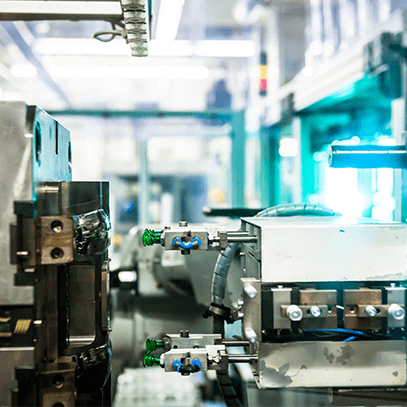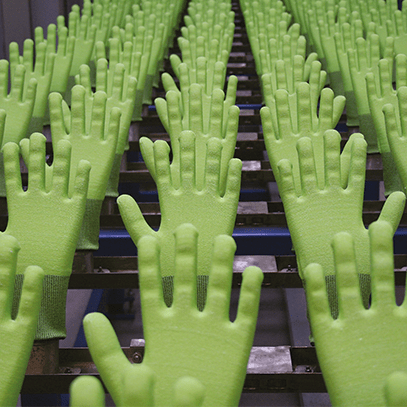
uvex safety textiles (Ellefeld)
New cut technology
At the Ellefeld site, a state-of-the-art cutter and an automatic placement machine with two twenty metre-long conveyor belts were commissioned during the last financial year. As a result of this measure and CAD position optimisation, fabric is being used much more efficiently. The cutter does not require a gap between cut pieces (zero millimetres), and position optimisation interleaves the cut pieces perfectly to ensure the least possible fabric waste when working with PPE and workwear materials. The long belts boost efficiency even further.
The new state-of-the-art cut technology, that has been in use in Ellefeld since October 2017, saves several tens of thousands of metres of material every year, which no longer needs to be produced (and purchased). As a result, this means less fabric needs to be produced, which was previously wasted as offcuts. The sustainability balance has now improved significantly. Furthermore, depending on the cut, only the complete cut parts (without offcuts) are now sent, saving further CO2 emissions in transportation. This measure has transferred jobs to the production location in Germany.

uvex Arbeitsschutz (Fürth)
Replacement of central optidur with innovative flood cells
The gradual replacement of the central optidur used to coat lenses with innovative flood cells saves energy and paint and also means that improved performance can be achieved in the coating process. Shorter set-up times allow for quicker changeovers between different models and paint systems, significantly increasing the quality of coatings that can be achieved. The energy consumption of the new flood cells is also lower than the optidur, despite improved output and higher variability. This means that nearly 44,000 kWh energy can be saved every year, which is equivalent to the average annual consumption of eleven four-person households. Solvent use has also dropped: In the past financial year, we reduced solvent use by almost five tonnes.
DIN EN ISO 14001 - environment management system
With the introduction of an environment management system in accordance with DIN EN ISO 14001, the uvex group is making a further contribution to reducing the environmental impact of its production operations.
By giving priority to environmental concerns in this manner, this has further sharpened the group’s awareness of environmental protection.

uvex safety Cagi (Ceva)
The production site for safety shoes in Ceva, Italy, was the pioneer, which with its optimum process structure serves as a model for the gradual roll-out throughout the uvex safety group. As part of its certification, a comprehensive waste management system was also established on the site, which further improves the efficient and environmentally-friendly disposal of waste. Among others, a project centred on recycling polyurethane residues has been successfully completed. This involved preparing discarded sections of polyurethane soles used in the footwear production process with external partners to be reused as a primary material in manufacturing, thereby reducing the use of new raw materials. A recycling rate of 35% was achieved here. During an incident involving a chemical leak, comprehensive risk management forming part of the environmental management system meant that negative environmental effects could be avoided. Isocyanate leaked from a tank out of a leaky valve on a production machine over the weekend. Thanks to an alarm issued by the level sensor, swift action was taken and the operating emergency management system was activated, which meant that a chemical spill into the environment could be prevented in collaboration with specialists. A comprehensive follow-up was conducted on the incident and measures were defined, which will ensure that such an event can never happen again in the future.

uvex safety gloves (Lüneburg)
The development, production and distribution location for safety gloves in Lüneburg is another location which was successfully certified in accordance with DIN EN ISO 14001:2015 in the past financial year. The great commitment shown by the environmental team meant that complete standard conformity could be achieved within the space of nine months.
On 1 August 2017 the new Commercial Waste Ordinance (GewAbfV) came into force. The aim of legislators with this amendment is, amongst others, the separate collection of recyclable material waste in order to boost recycling. At uvex safety gloves, this has led to greater requirements as regards separate collection and documentation. With the new and comprehensive waste management system, the disposal of all waste fractions has been improved significantly. The entire disposal chain is therefore more transparent and meets the legal requirements of the new GewAbfV in full. An extensive actual state analysis was conducted, which identified a large amount of potential to optimise efficiency, some of which has already been realised. Waste is currently broken down into more than 40 different waste fractions, which can each be recycled thanks to their material purity, enabling environmentally-friendly and efficient waste disposal. The separate collection rate for waste is >98%.
A production dryer was converted from electric to gas operation, saving considerable energy in the production of safety gloves while maintaining the same drying performance, thereby cutting CO2 emissions and reducing negative environmental effects. At the same time, by expanding the capacity of a production facility used to coat gloves, energy requirements per pair of safety gloves produced were also reduced by 50%.

uvex Arbeitsschutz (Fürth)
In preparation for the introduction of DIN EN ISO 14001 at the main site in Fürth, construction of a new recycling centre was commenced in the 2017/18 Financial Year which complies with the latest standards and requirements. Waste management for the entire site is set to be conducted here. In future, the various waste fractions will be collected in a way that saves space, considerably reducing the number of collections and therefore the disposal organisation’s pollutant emissions, too. Optimal distribution of the various fractions will mean we can continue to ensure efficient and environmentally-friendly waste disposal.